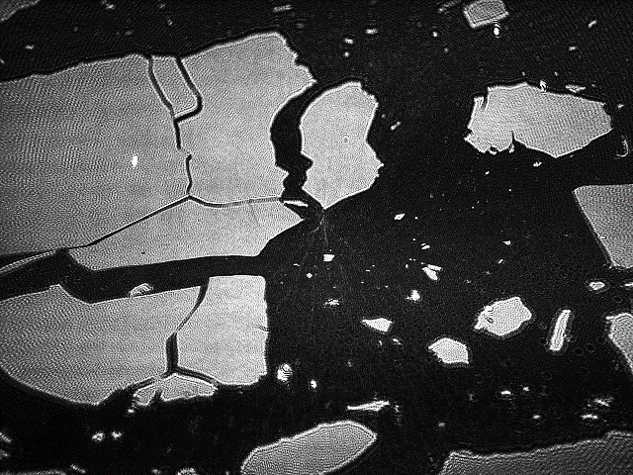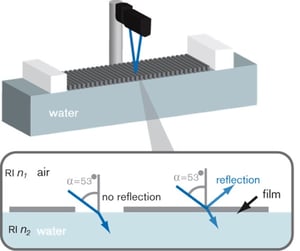
When a light beam hits a surface, it usually reflects from it. If a p-polarized light beam is directed at a clean surface at a unique angle, no reflection occurs. If the properties of the interface change, the reflection will occur. This behavior is explained by Brewster’s law which describes the use of the Brewster angle (α) for an optical media with a refractive index of n.
Brewster angle microscopy was first introduced in 1991. Since its introduction, it has become the standard technique for the imaging of thin films on liquid surfaces. When combined with a Langmuir trough, the method can be used to relate the BAM images with characteristic phase transition points in a Langmuir isotherm. This gives valuable information on the formation dynamics of the monolayer.
The working principle of Brewster angle microscopy is very simple.  A p-polarized light beam is directed to the air-water interface at the Brewster angle. For the air-water interface, the angle is 53 ° which can be easily calculated from the reflective indexes of the phases.
A p-polarized light beam is directed to the air-water interface at the Brewster angle. For the air-water interface, the angle is 53 ° which can be easily calculated from the reflective indexes of the phases.
Tan α = n2/n1
For air n1 = 1 and water n2 ≈ 1.33. When the light hits the areas where no thin film is present, there is no reflection and the image is seen as black. When even just a monolayer is on the interface, the Brewster law is not fulfilled, and the reflection occurs.
Brewster angle microscopy enables visualization of Langmuir monolayers or adsorbed films at the air-water interface. As the measurements are typically done in Langmuir troughs, the images can be taken as a function of surface pressure (i.e. packing density of the molecules). Brewster angle microscopy is used to study the properties of the Langmuir layer or to indicate the suitable surface pressure for the Langmuir-Blodgett deposition.
Langmuir films of lipid monolayers are often used as model structures of cell membranes. Brewster angle microscopy images at characteristic phase transitions of the surface pressure - area isotherm give valuable information on the structural and orientational changes in the monolayer. The published data includes BAM images of molecular interactions, lipids in different ionic environments and nanoparticle interactions. Since BAM allows for direct observation of lipid monolayers during compression, it is especially valuable in the imaging of tear fluids and biological liquids.
The Langmuir technique is an effective way of fabricating single-particle thick layers of lipids, polymers, and nanoparticles on liquid surfaces. A Langmuir film can be transferred onto the desired substrate, creating new possibilities for fabricating nanoscale layers and functional surfaces on various materials. Brewster angle microscopy has been used for finding the optimized transfer conditions of metal nanoparticles and graphene oxide.
There is an increased interest in understanding the properties and behavior of asphaltenes and other surface-active materials in crude oil. Langmuir troughs are excellent tools for examining the layer formation of such water-insoluble surfactants. Brewster angle microscopy has been used to show the layer formation properties of asphaltenes and model compounds.
For more detailed examples of how Brewster angle microscopy can be used please download the overview below.
